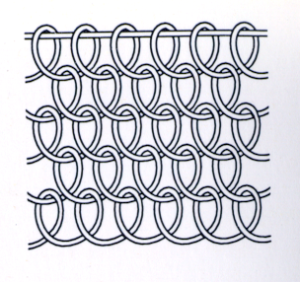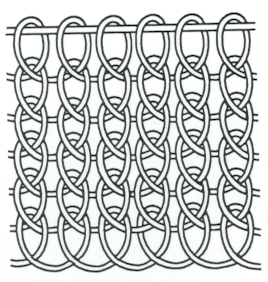During the period from around 100 B.C. to 400 A.D., Nasca needleworkers from the South Coast of Peru mastered the complex art of three-dimensional cross-looping. A number of colorful and complicated border fragments like this one have been preserved. The few garments that remain intact show that they were used as the outer edging attached to an undecorated, monochrome rectangular cloth used as a shoulder mantle. The contrast between the plain, simple groundcloth and the incredibly busy three-dimentional border could not be greater. One wonders how the garment would have been draped on the body — dangling borders would have certainly been animated if worn while dancing or swaying in movement during a ritual procession. Associated with elite burials within the Nasca valley, their life-affirming representations of hovering hummingbirds retrieving nectar from the bountiful flowers speak to the natural cycles of fertility and growth.
Of all the techniques used in the Andes for the making if special textiles, the Nasca chose to use needles and yarns to create their masterpieces. The mantles are associated with the magnificent burials from the Paracas Peninsula, approximately 214 kilometers to the north of the Nasca Valley, whose embroidered garments were meticulously covered with religious iconography. The link between the makers of the Paracas materials and the artisans residing further south is still not clear, even for scholars who have spent lifetimes of study, but evidence of shared culture between the Paracas and Nasca textiles can be seen in the iconography that emphasized birds, flowers and plants.
The abundance of camelid hair yarns in so many colors speaks to the active artisan culture of the region. Yarns from llamas, alpacas and possibly vicuña are used, each with special qualities. The coarser llama hair may be the source of the component created for the underlayer of the looping, while the finer alpaca hair may have been used for the majority of the needlework. The animal hairs, which naturally occur in an array of colors ranging from white, cream, browns, black and gray used as they are found in nature. The majority of yarns, however, were dyed with numerous natural dyes from plants (and perhaps some animals). The strong, beautiful color array, preserved for thousands of years, indicates the depth of knowledge applied to the dyeing of yarns. Some colors are the result of single dye baths, while others would be made through a sequence of dyeing and overdyeing—especially for greens (indigo plus a yellow dye) and purples (indigo plus a red dye). Some purples used in other textiles from the region may have been made with shellfish dye coming from the nearby rocky coast, though these have not been scientifically tested. A few yarns, more rarely encountered in Nasca textiles, are bi-color, formed after dyeing and spinning two different colored yarns together. In many ways, these bi-colored yarns are quite special, sparsely used in very specific areas.
The cross-looping technique used to create these borders was developed over time, and the distinctive loop with v-shaped crossing created with a continuous yarn threaded on a needle, was applied to a number of surfaces —used as embellishments for seams and edgings of textiles as a kind of embroidery on cloth, as well as the three-dimensional stand-alone-constructions, such as we see in this example, constructed in the round with or without a ground. Generally, the looping is constructed as sequences of horizontal rows, often formed in circular or spiral pathways. While having the appearance of knitting—a process that forms loops into loops—the cross-looping structure forms loops around the previously crossed yarns along each row. The pathway of the single yarn on its needle begins at the lower end, going up and around to form the loop, carrying the continuous yarn diagonally downward while crossing over the initial upward sweep. The ‘V’ shape seen in the resulting cross then serves as the place for the next row’s loops to connect by crossing around each ‘v’, loop by loop and row by row. When finished, the crossed loops appear as if they were formed in vertical columns, when looking at the sequence of the ‘v’s, though in fact they are formed in horizontal rows.
The construction of these small, three-dimensional works required enormous planning and skill. To construct the birds’ heads, for example, the artist first constructs a shaped unit formed of simple looping. (Simple looping is formed by rows of loops, though unlike the crossed-looping, the simple loops are formed at the swag of the loop, rather than around its crossing.) Using the unit as a base, the cross-looping is formed around all sides, as all the borders are double-sided and can be seen in the round. The long, tubular beaks of the birds, as well as some of the flower petals and stems may be formed around doubled lengths of yarns that serve as the understructure. The looped yarns are worked in a circular fashion, forming the rows of loops that are connected around the crossing of the yarn in its pathway. The central band is formed on top of a woven narrow plainweave tape, that serves as it base for the needlelooping. The three tail feathers of each bird are created around a structure of doubled yarns that form a core for the needlework, similar to the flowers. With the large number of different colored yarns, a question remains how the artisans managed to constantly change colors, to form the patterns and designs. Likely many of the yarns were carried within the structure, underneath the outer looping—in this way helping to bulk-up the three-dimensionality of the finished work. In areas where yarns have deteriorated, we can see that unused yarns are carried, when not required for the design, along the row, but kept at the back. Still, the management of these many colors is a remarkable skill, coupled with the incredible concentration required to execute the fine and complex needlework constructions, creating miniature masterpieces of textile art.

Simple Looping

Cross Looping, Diagrams from Irene Emery The Primary Structures of Fabrics, 1966
Elena Phipps, Ph.D., is an independent scholar who teaches textile history at UCLA. A former conservator and special curator at the Metropolitan Museum of Art, she has published a number of books and articles on textile culture, techniques and history. Her recent publications include Cochineal Red, the art history of a color (New York: Metropolitan Museum of Art, 2010) Looking at Textiles (Los Angeles: Getty Publications, 2013) and The Peruvian Four-Selvaged Cloth: ancient roots, new directions (Los Angeles: The Fowler Museum, 2013), among many others.
For further reading, see:
Irene Emery, Primary Structures of Fabrics (Washington, D.C.: Textile Museum, 1966).
Lila M. O’Neale “Needleknitting.” American Anthropologist, New Series, Vol. 36, No. 3 (Jul. – Sep., 1934), pp. 405-430. Stable URL: http://www.jstor.org/stable/662153
Alan Sawyer, Early Nasca Needlework (London: Laurence King Publishing, 1997).
For information about a recent project in Cuzco to revive the technique: https://www.clothroads.com/reviving-a-pre-columbian-textile-technique/
